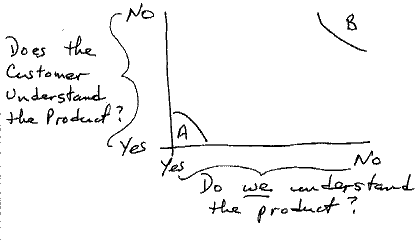
The article is "Organizing for Effective New Product Development: The
Moderataing Role of Product Innovativeness" by Olson, Walker, and Ruekert
in the Journal of Marketing Vol 59, Jan, 1995.
The question they asked ws, is there one type of organizing and
coordinating structure that would be uniformly succesful in delivering
more creative new products, cutting development time, and improving new
product success in the marketplace. They concluded that the degree of
innovativeness of the product being developed was a key determinant of the
'best' coordinating structure.
What they found was that when the product was a line extension of existing
products, then the customer understood it, and the producing company
understood it. In that environment, a functional organization was the
most effective way to deliver the product. For a truly new product --
where the customer did not understand the product, and the producer did
not understand it (had never produced anything like it), then a
stand-alone development team was the most effective approach.
The way I understand this is as follows. Imagine an x-y plot with a
vertical axis labeled "Customer understands the product" with 'yes' at the
bottom and 'no' at the top (wouldn't a picture be greta here?). Imagine
the horizontal axis being "production process is understood" with 'yes' at
the left and 'no' at the right. Then at the bottom left of the plot, the
customer understands the product, and there are no production mysteries.
At the top right, the customer does not understand the product (microwave
in 1960) and no one has ever produced one in quantity.
[Host's Note: I asked Rol to fax me a drawing of the diagram he
envisions. Here it is:...]

The gist of the article is that in the lower left, (production
well-understood, and customer understands the product) functional
organizations are most effective, efficient, and successful. At the upper
right (maximum uncertainty) then a stand-alone design team is most
successful.
There is some rich material that explains this in more detail. The paper
describes the strengths and weaknesses of teams as they relate to a
product development. Teams are great for reducing barriers and
facilitating the open exchange of creative ideas across multiple
functions. On the other hand, they are costly and slow. They require
redundancy in functions in order to dedicate people to an individual team.
Communications patterns, participative decision-making, and consensual
conflict resolution are time consumning and less efficient. Unorganized
communications are slow, uncertain, and lead to people feeling a lack of
progress.
Whereas the greater efficiency of functional structures may make them
appropriate for relatively familiar, incremental types of development
projects in which participants have substantial experience to draw on and
functional interdependencies are low, they are likely to be less effective
for managing more complex and innovative projects.
When the product concept being developed is unfamiliar and high functional
interdependence demands frequent and direct resourc flows among the
participants, more organized and participative mechanisms are likely to
produce better outcomes.
Put another way, the less experience a company and a market have with a
product, the greater the difficulty of successful implementation. The
greater the level of difficulty of implementation, the greater the
interdependence among participating functional specialists. The greater
the level of interdependence, the greater the need for communication. The
greater the need for communication, the greater use of informal
coordinating structures. If you follow those logical connections, they
do, ultimately make sense.
The next part is the most dramatic. After studying dozens of projects in
large firms, they found the better the fit between the organizational
approach and the firm's experience level with the product concept, the
greater the degree to which the project came in on budget and on time.
And, the better the fit between the firm's experience level with a product
concept and the organizational structure, the greater a) the sense of
personal satisfaction felt by participants in the proces, b) the feeling
by individuals that they made a substantial functional contribution, and
c) the feeling by individuals that their home departments' objectives were
met within the project.
If we were to extend the findings beyond the boundaries of this study
(always a risky proposition), the conclusion might be as follows.
If the organization is familiar with the task to be accomplished, then a
functional approach or any of a number of matrix organizational approaches
will result in the best results, and the best participant satisfaction
with the results. If, on the other hand, the company is breaking new
ground, then a stand-alone cross-functional team will result in the best
outcome and the best participant satisfaction.
Caveats are,of course, in order. On the other hand, this article begins
the complex task of defining when teams are most likely to work, and when
another structure may be best. As George Bernard Shaw said, "The solution
to a complex problem is oftentimes simple -- and its usually wrong."
Teams may not be the single best answer to all problems.
-- Rol Fessenden LL Bean 76234.3636@compuserve.com